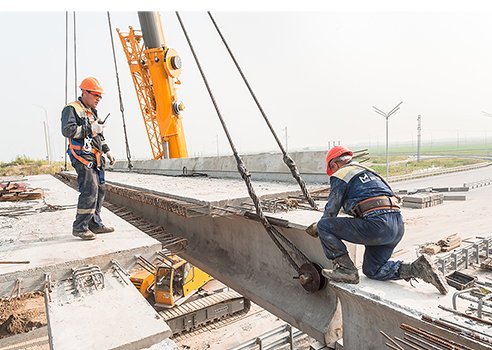Reading time: Less than 3 minutes
Communicators need to use writing transitions — or bridges — from one sentence to the next. In that sense, we’re a little bit like ironworkers…
Bridges, connectors or transitions are the words, phrases and stylistic devices that help direct readers through our writing. Sometimes I even like to imagine them as cables that pull our readers along, or hidden invisible stitches that help knit our whole piece of writing together.
As writers, we come to our work with a great deal of background knowledge. After all, we did the research. We interviewed the sources. We thought about the story. Then, we wrote and edited it.
But pity the poor, naive reader. He or she is coming to all this information for the first time. It’s new and perhaps confusing. Bridges, connectors or transitions can help prevent this confusion.
Experienced writers lard their copy with transitions. Newbies almost never use them frequently enough.
Here are five techniques for bridging that I suggest you try the next time you write:
1) Make “leading” or intriguing statements that will raise a question in the reader’s mind. Then answer that question in the very next sentence. Let me give you an example from the New York Times:
Andrea Seifert, the marketing manager of Gatehouse Publishing, travels a lot from Singapore through different time zones on business. She has found a lifesaver in something that used to belong pretty exclusively to the men’s club: a watch with complications….
I’m not the least bit interested in watches, but the phrase “a watch with complications…” grabbed my eyeballs and wouldn’t let go. This forced me to read into the next sentence to learn that, for frequent travelers, some watches can track more than one time zone and that moon-phase watches are popular with women tracking their haircuts. Really! (See here.)
2) Sprinkle your article with questions. For example, in a New York Times article on Sir Nicholas Winton, Op-Ed writer Roger Cohen asks, “By what right, after all, had one lived when those 250 children had not?” Born in Prague, 105 years ago, Winton had helped rescue some 669 children, most of them Jews, from Nazi-occupied Czechoslovakia in 1939. But one train, containing 250 children, had been cancelled. As you can see, the question makes you want to read more, and Cohen segues gracefully into a quote from former Israeli Prime Minister Menachem Begin.
3) Whenever you are quoting someone, be sure to include some paraphrasing to “set up” the quote. This is an especially effective bridge as you can see in this story about New York governor Andrew Cuomo dealing with the aftermath of Hurricane Sandy.
Even the report’s main recommendation, to privatize the authority, was misleading: Some commissioners disagreed, but the governor’s office changed the report to read as though the panel had been unanimous. “The license they took to manipulate things was really something,” said Peter Bradford, a member of the post-hurricane commission.
See how the quote doesn’t introduce new material — it simply expands on the point raised in the previous sentence. But paraphrasing helps “pull” the reader through to learn the specifics.
4) Repeat words or key concepts. Remember my third graf at the beginning of this post? I said:
But pity your poor, naive reader. He or she is coming to all this information for the first time. It’s new and perhaps confusing. Bridges, connectors or transitions can help prevent this confusion.
Notice how I used the word confusing in the second sentence and then echoed it with the word confused in the third. That, too, is a bridge. (And guess what? In the third sentence I also repeated the words, bridges, connectors or transitions, which I’d used in the very graf of the story.) Repetition is an extremely effective type of bridging.
5) Use any in the following list of common transitional words/phrases to help demonstrate to your reader that you’re guiding them by the hand. (You might want to print out this list and stick it to a bulletin board near your computer.)
Addition: also, and, furthermore, in addition, in fact, let alone, moreover, nor, or, too
Clarification: basically, in other words, put differently
Emphasis: above all, besides, even more, indeed, more importantly
Example: as, for example, for instance, here, in fact, including, like, my point is, specifically, such as, the evidence shows, there, to illustrate
Cause & effect: accordingly, as a result, because, consequently, hence, so, thus
Comparison: also, as well, besides, likewise, similarly, too
Contrast: although, but, conversely, however, in contrast, nevertheless, on the other hand, still, though, this is not to say, unlike, when in fact, whereas, while, yet
Sequence: finally, first, last, next, second, third
Summation: altogether, as I have said, consequently, in short, on the whole, to summarize, therefore
Time: after, following, in the past, later, meanwhile, now, preceding, soon, then, while
Building bridges isn’t just a task for engineers and ironworkers. It’s a key job for writers, too.
Do you use transitions? Can you give an example of a favourite one? We can all learn from each other so, please, share your thoughts with my readers and me in the “comments” section. (If you don’t see the comments, go here and then scroll to the very end.) And, congratulations to Bharathi Ram, the winner of this month’s book prize, Boy, Snow, Bird for her Oct. 9/14 comment on my blog. Anyone who comments on today’s blog post (or any others) by Nov. 30/14 will be put in a draw for a copy of the non-fiction guide Blog Inc. by Joy Deangdeelert Cho.


